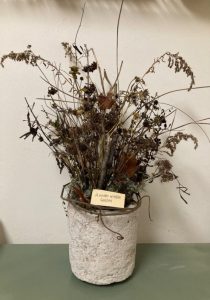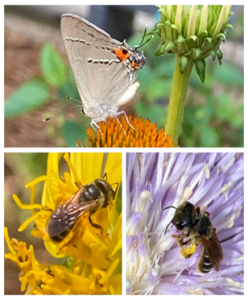 What do you see in the photo on the left?
What do you see in the photo on the left?
- A container of useless dead plants
- A bouquet of pollinator plants in their “winter” form
- A container showing plants that are a source of nesting and shelter for our over-wintering native pollinators
To pollinator gardeners, the correct answers are B and C.
From spring through fall, pollinator plants provide a habitat of food and shelter for our native bees, butterflies and other pollinators. But what happens during our short winter months as the presence of our pollinators decreases?
Our winter may seem understated compared to other states, but even in our mostly mild winter months, many of our native plants (as well as Florida-Friendly non-native pollinator plants) have a dormant season, with the dried appearance of branches, stems and spent flower seed pods. During this period, these plants lose their cheerful color and appear, well – brown! Yet, these “untidy” brown stems, branches, leaves, and dried seed pods provide valuable nourishment and nesting spots for many of our pollinators that may over-winter in your own pollinator garden!
What happens in a winter pollinator garden?
- Some native bee species overwinter by creating nesting chambers in hollow or pithy stems of wildflowers such as native milkweed, goldenrod, purple coneflower, aster species, and others.
- Some native bees lay eggs in beetle holes of dead or decaying wood.
- Other native bees build nests directly in the ground.
- Moths, bees, and other insects lay eggs in leaf litter or open sandy areas.
- Some butterflies over-winter as eggs or chrysalises.
While it is tempting to prune back dried plant materials, by leaving them in their natural winter form you can maintain a pollinator habitat for the entire year and be rewarded with emerging pollinators early in the spring.
Some tips on providing winter habitat for pollinators:
- Provide ample areas in your yard that are open, without turfgrass. In these areas, provide no or light mulch. Thin layers of leaves are perfect for this; pine needles are also great for adding cover for the insects, but don’t lay down so thick as to be inaccessible. If your leaves are thick (such as below an oak tree), rake some away and use as mulch in other areas of your yard. Learn to recognize these nests (small sandy mounds with a circular hole in the center). Don’t disturb these mounds or cover up the hole – the bees need to be able to emerge in the spring.
- Leave your dried wildflower stems – as those with hollow or pithy centers are perfect for native bees who build nesting chambers within. If you must prune, cut to varying heights from 12-18 inches tall. Leave the cut stems on the ground.
- Decaying wood has many benefits for our pollinators. Leaving varying sizes of twigs and branches in your landscape can be creative and fun! Provide piles of twigs and branches in small areas over your landscape. Line natural paths and define plant beds with larger branches. Observe these small wood “piles”, and over time you’ll be rewarded with rich discovery as you witness holes in the wood, and the breakdown of older branches and twigs as they become soil! Mother nature gives fascinating surprises!
- Don’t forget our resident and migrating birds, as they too can benefit from your winter pollinator garden. Dried berries, seed pods and insects that live in decaying wood all provide food for our visiting birds.
- In very mild winters, some of our native and non-native pollinator plants will continue to bloom and supply nectar to pollinators that may still be present.
- As always, avoid pesticides in and around your pollinator garden.
One final thought on a winter pollinator garden: consider making peace with an untidy winter garden appearance, at least in a portion of your landscape.

There is a beauty in the architecture of a winter garden,
a stillness and a calm invitation to rest
AND YET!
Your winter stems, branches seed pods and leaves are working still!
Bees and butterflies and color will
Be here before you know it!
For more information, contact UF/IFAS Extension Polk County at (863) 519-1041 or visit us online at http://sfyl.ifas.ufl.edu/polk. The Plant Clinic is open Monday-Friday, 9:00 am-4:00 pm to answer your gardening and landscaping questions. Give us a call or email us at polkmg@ifas.ufl.edu.
If you are not in Polk County, Contact your local UF/IFAS Extension Master Gardener Volunteer Plant Clinic.
The Florida Master Gardener Volunteer Program is a volunteer-driven program that benefits UF/IFAS Extension and the citizens of Florida. The program extends the vision of the University of Florida/Institute of Food and Agricultural Sciences, all the while protecting and sustaining natural resources and environmental systems, enhancing the development of human resources, and improving the quality of human life through the development of knowledge in agricultural, human and natural resources and making that knowledge accessible.
This article was written by Master Gardener Volunteer Molly Griner under supervision of the Master Gardener Volunteer Coordinator and Residential Horticulture Extension Agent Anne Yasalonis.
An Equal Opportunity Institution.
Source: UF/IFAS Pest Alert
Note: All images and contents are the property of UF/IFAS.



